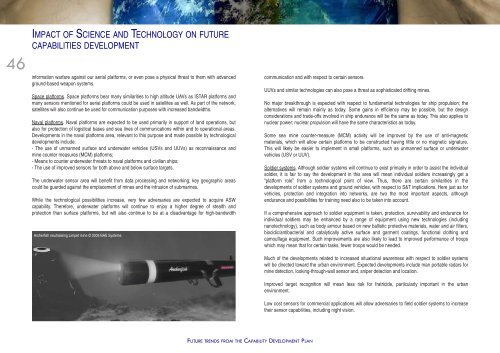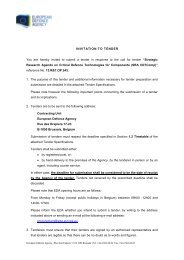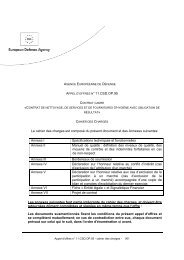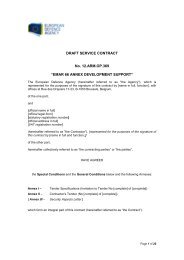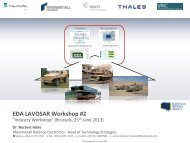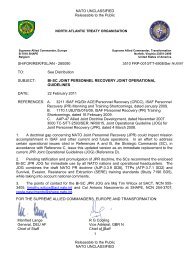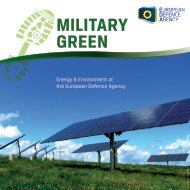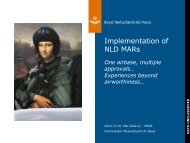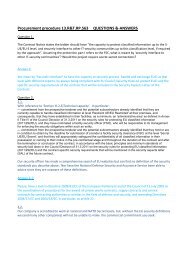capability development plan - European Defence Agency - Europa
capability development plan - European Defence Agency - Europa
capability development plan - European Defence Agency - Europa
You also want an ePaper? Increase the reach of your titles
YUMPU automatically turns print PDFs into web optimized ePapers that Google loves.
46<br />
IMPACT OF SCIENCE AND TECHNOLOGY ON FUTURE<br />
CAPABILITIES DEVELOPMENT<br />
information warfare against our aerial platforms, or even pose a physical threat to them with advanced<br />
ground-based weapon systems.<br />
Space platforms. Space platforms bear many similarities to high altitude UAVs as ISTAR platforms and<br />
many sensors mentioned for aerial platforms could be used in satellites as well. As part of the network,<br />
satellites will also continue be used for communication purposes with increased bandwidths.<br />
Naval platforms. Naval platforms are expected to be used primarily in support of land operations, but<br />
also for protection of logistical bases and sea lines of communications within and to operational areas.<br />
Developments in the naval platforms area, relevant to this purpose and made possible by technological<br />
<strong>development</strong>s include:<br />
- The use of unmanned surface and underwater vehicles (USVs and UUVs) as reconnaissance and<br />
mine counter measures (MCM) platforms;<br />
- Means to counter underwater threats to naval platforms and civilian ships;<br />
- The use of improved sensors for both above and below surface targets.<br />
The underwater sensor area will benefit from data processing and networking; key geographic areas<br />
could be guarded against the emplacement of mines and the intrusion of submarines.<br />
While the technological possibilities increase, very few adversaries are expected to acquire ASW<br />
<strong>capability</strong>. Therefore, underwater platforms will continue to enjoy a higher degree of stealth and<br />
protection than surface platforms, but will also continue to be at a disadvantage for high-bandwidth<br />
Archerfish neutralising Limpet mine © 2005 BAE Systems<br />
communication and with respect to certain sensors.<br />
UUVs and similar technologies can also pose a threat as sophisticated drifting mines.<br />
No major breakthrough is expected with respect to fundamental technologies for ship propulsion; the<br />
alternatives will remain mainly as today. Some gains in efficiency may be possible, but the design<br />
considerations and trade-offs involved in ship endurance will be the same as today. This also applies to<br />
nuclear power; nuclear propulsion will have the same characteristics as today.<br />
Some sea mine counter-measure (MCM) activity will be improved by the use of anti-magnetic<br />
materials, which will allow certain platforms to be constructed having little or no magnetic signature.<br />
This will likely be easier to implement in small platforms, such as unmanned surface or underwater<br />
vehicles (USV or UUV).<br />
Soldier systems. Although soldier systems will continue to exist primarily in order to assist the individual<br />
soldier, it is fair to say the <strong>development</strong> in this area will mean individual soldiers increasingly get a<br />
“platform role” from a technological point of view. Thus, there are certain similarities in the<br />
<strong>development</strong>s of soldier systems and ground vehicles, with respect to S&T implications. Here just as for<br />
vehicles, protection and integration into networks, are two the most important aspects, although<br />
endurance and possibilities for training need also to be taken into account.<br />
If a comprehensive approach to soldier equipment is taken, protection, survivability and endurance for<br />
individual soldiers may be enhanced by a range of equipment using new technologies (including<br />
nanotechnology), such as body armour based on new ballistic protective materials, water and air filters,<br />
biocidic/antibacterial and catalytically active surface and garment coatings, functional clothing and<br />
camouflage equipment. Such improvements are also likely to lead to improved performance of troops<br />
which may mean that for certain tasks, fewer troops would be needed.<br />
Much of the <strong>development</strong>s related to increased situational awareness with respect to soldier systems<br />
will be directed toward the urban environment. Expected <strong>development</strong>s include man portable radars for<br />
mine detection, looking-through-wall sensor and, sniper detection and location.<br />
Improved target recognition will mean less risk for fratricide, particularly important in the urban<br />
environment.<br />
Low cost sensors for commercial applications will allow adversaries to field soldier systems to increase<br />
their sensor capabilities, including night vision.<br />
FUTURE TRENDS FROM THE CAPABILITY DEVELOPMENT PLAN


